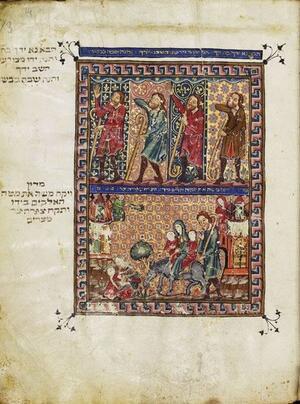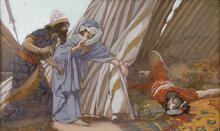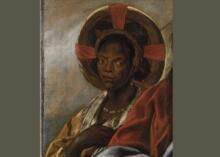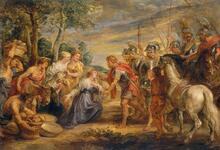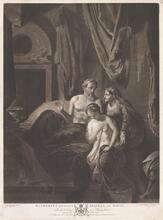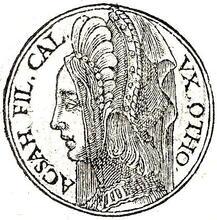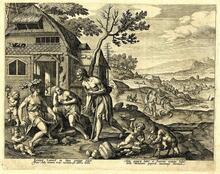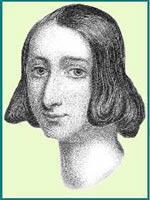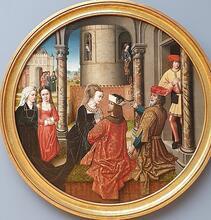Zipporah: Midrash and Aggadah
Zipporah was the wife of Moses. The Rabbis ascribe many traits to her; they considered her different than other women, in a positive sense, in both appearance and deed. She heroically saved Moses from an attack by circumcising her son. Zipporah’s actions led to a Talmudic discussion of women’s ability to perform circumcision. The Rabbis explain that Moses sent Zipporah to her father’s house in Midian only out of fear that Egyptian servitude would harm her. After the Giving of the Torah, a life of sexual abstinence was imposed on Moses. Zipporah found very this difficult and she Miriam, forming a bond of feminine solidarity as Miriam lent an attentive ear and tried to help.
The Rabbis ascribe many traits to Zipporah, whom they considered as differing from other women, in a positive sense, in both appearance and deed. A beautiful woman, she had received a special blessing that her comeliness would last her into old age. She is also described as a practical woman capable of taking action at the right moment. When her father identified Moses as his future son-in-law, she ran to bring him from the well, and hence became his wife. She saved his life in the night encampment when she made haste to circumcise her son. Moses was aware of Zipporah’s qualities and therefore took her for a wife; she adjusted to her role as wife of the leader of the people of Israel, successfully making the transition to royalty. The Rabbis explain that Moses never wanted to part from Zipporah and sent her to her father’s house in Midian only for fear that the Egyptian servitude would harm her. After the Giving of the Torah she-bi-khetav: Lit. "the written Torah." The Bible; the Pentateuch; Tanakh (the Pentateuch, Prophets and Hagiographia)Torah, a life of sexual abstinence was imposed on Moses due to his spiritual standing; this Zipporah found very difficult.
The Meeting at the Well
As with other major Biblical figures, the venue of the first encounter between Moses and Zipporah, his future wife, was beside a well (Ex. 2:15–17). In the midrashic expansion, when the daughters of Jethro returned home, they told their father that a stranger had saved them from the shepherds, and he asked them: “Why did you leave the man? Ask him in to break bread” (Ex. 2:20). With the words “to break bread" (implying marriage), Jethro hinted that Moses might marry one of them. Upon hearing her father, Zipporah immediately ran after Moses like a bird (ke-zippor, i.e., with alacrity) (Ex. Rabbah 1:32). According to this A type of non-halakhic literary activitiy of the Rabbis for interpreting non-legal material according to special principles of interpretation (hermeneutical rules).midrash, Zipporah wanted to marry Moses, acted accordingly, and achieved her goal.
A second tradition has Jethro deciding upon Zipporah’s marriage to Moses after he brought Moses into his home and came to know his qualities. Jethro was one of the magicians of Egypt, and when he saw Pharaoh’s staff with its magical symbols, he desired it and took it. He planted the staff in the garden of his house, and no man could approach it. When Jethro invited Moses into his house, the latter entered the garden and saw the staff. He read the symbols on it, extended his hand, and took it. When Jethro saw what Moses had done, he exclaimed: “This one will redeem Israel from Egypt,” and therefore gave him his daughter Zipporah in marriage (Pirkei de-Rabbi Eliezer [ed. Higger], chap. 39).
In a third tradition, the initiative to marry Zipporah came from Moses himself. When he was with Jethro, he saw how fine were her actions. He went to Jethro and asked: “Give me your daughter Zipporah in marriage.” Jethro replied: “Do you want to do to me what your ancestor Jacob did? When Laban gave him his daughters, Jacob deceived him and fled far away. If you are asking me to give you Zipporah, swear to me that you will not take her far away from me; I will give her to you only upon this condition.” Moses immediately swore to him, as it is said: “Moses consented [va-yoel] to stay with the man” (Ex. 2:21), understanding the word “va-yoel” as a customary wording of a vow. Because of this pledge, Moses had to return to Midian after he had been sent to Egypt, as it is said (Ex. 4:18): “Moses went back to his father-in-law Jether [yeter],” from which the Rabbis learn that Moses went to Egypt, but returned to Midian to be released from (le-hatir) his vow (Ex. Rabbah 2:33; Mann, Fragments from the Geniza, fragment 12, p. 95). In another midrashic account, Jethro agreed to the marriage between Moses and Zipporah on condition that their firstborn would be an idolater (see below).
Did Zipporah Go Down to Egypt?
Ex. 4:20 relates that Moses took Zipporah and his two sons, Gershom and Eliezer, when he returned to Egypt, and describes an incident that occurred on their journey in the night encampment. In the midrashic presentation, Moses took them with him because he wanted them to be with the Israelites when they received the Torah (Ex. Rabbah 5:5). The members of Moses’s family are not mentioned in the narrative of the ten plagues and the Exodus from Egypt and reappear only in the family reunion in Ex. 18:2–6, when Jethro brings Zipporah and her two sons to Moses in the wilderness, “after she had been sent home” (v. 2). This teaches that at some point Zipporah and her sons had been sent back to Midian, where they stayed with Jethro until he brought them to Moses in the wilderness. The Torah does not specify when Zipporah left Moses, nor the reason for this parting.
In the midrashic amplification, Zipporah set out for Egypt with Moses, but never arrived there. Their parting took place on the way, following the encounter with Aaron. Moses and the latter met at the mountain of God when Moses was on his way to Egypt (Ex. 4:27–28). Aaron goes forth to greet his brother and hugs and kisses him. He asks him: “Moses, where were you all these years?” To which Moses answers: “In Midian.” Aaron further asks him: “Who are these children and women with you?” Moses replies: “My wife and my sons.” Aaron continued to question him: “And where are you taking them?” The answer: “To Egypt.” Aaron then tells him: “We are grieving for the first ones [the Israelites who are enslaved in Egypt], and now shall we grieve for these, as well?” Moses accordingly orders Zipporah: “Go to your father’s house.” Zipporah then departs for her father’s home, taking her two sons (Mehilta de-Rabbi Ishmael, Masekhta de-Amalek, Yitro 1).
These midrashim depict Moses as not wanting to part from his wife and children, but rather as wishing them to participate in the formative process of the people of Israel. His concern for his family’s welfare motivates him to send Zipporah back to her father’s home, in order to protect the lives of his family. Moses’s hope that his family would be present at the Giving of the Torah would nonetheless be realized, because the Torah tells of their reunion in Ex. 18, before the Giving of the Torah, which is immediately presented in the following chapters (Ex. 19–20).
The Rabbis sought to elicit the nature of the parting between Moses and Zipporah from the wording “after she had been sent home [shiluheha].” According to one opinion, Moses divorced her, with a writ of divorce, since shilu’ah also appears in Deut. 24:3–4, which speaks of a “bill of divorce.” Another view maintains that he separated from her orally (and therefore this was not a formal act of divorce) (Mehilta de-Rabbi Ishmael, Masekhta de-Amalek, Yitro 1).
Zipporah Circumcises Her Son
In the Biblical account, when Moses and Zipporah were on their way to Egypt, they stayed in a “night encampment,” where they were in mortal danger: “the Lord encountered him and sought to kill him” (Ex. 4:24). The predicate of this verse is unclear. It might refer to the child, for in response Zipporah cuts off her son’s foreskin and thus saves his life. Another interpretation, however, has this danger hovering over Moses, and in order to save him, Zipporah circumcises their son. The latter understanding is based on Zipporah's declaration in the following verse (25) that “you are truly a bridegroom of blood to me,” which is directed to her “bridegroom,” Moses.
Both possibilities appear in the midrashic expositions. One is that Satan sought to kill the uncircumcised baby, and the appellation “a bridegroom [hatan] of blood” was given to the child himself, who thereby become a hatan (the title given to the child who undergoes circumcision). The second position is that Moses was negligent regarding his son’s circumcision. “Af and Hemah” (the destructive angels of “wrath” and “anger”) came and swallowed Moses, leaving only his legs. How did Zipporah know that Moses’s life was threatened because of the circumcision? When she saw that they swallowed him until the place of circumcision, she understood the danger, took a piece of flint and cut off her son’s foreskin, whereupon the destructive angels relinquished their hold on Moses (BT Nedarim 32a; Ex. Rabbah 5:8).
The midrash explains how Moses and Zipporah could have had a son who had not been circumcised. When Moses asked Jethro to marry his daughter Zipporah, Jethro had told him: “If you accept the thing that I will tell you, then I will give her in marriage to you.” Moses asked: “What is this thing?” To which Jethro replied: “The first son born to you shall be for idolatry, and your following sons will be for Heaven.” Moses accepted Jethro’s condition (Mehilta de-Rabbi Ishmael Masekhta de-Amalek, Yitro 1). This exegesis explains why only one of Moses’s sons was uncircumcised, and why they were not in such mortal danger immediately after his birth, but only after they had left Jethro’s home and were released from his vow.
After Zipporah performed the circumcision, she took the foreskin and “touched his legs” (v. 25). Whose legs did she touch? The Rabbis interpret the vague wording of the verse in different ways. According to one hermeneutical position, Zipporah touched Moses’s legs and said to him: “Take retribution for your debt.” According to another interpretive approach, she touched the legs of the angel and said: “This is the culmination of your mission.” A third understanding has her touching the body of the child, and only then (v. 26) “He let him alone” (JT Nedarim 3:9, 38b).
Zipporah’s actions led to a Talmudic discussion of the ability of women to perform circumcision. Gen. 17:13 states “they must be circumcised [ha-yimol yimol, literally, he who is circumcised shall circumcise],” from which the Rabbis deduced that only one who is circumcised may circumcise others. The prevalent idea among the Rabbis is that a woman is qualified to perform circumcision; the fact that she herself does not require circumcision teaches that she is regarded as if she were already circumcised. An opposing view, however, argues that a woman is not deemed to be as if already circumcised; this commandment is not relevant for the woman, and since she herself is not circumcised, she may not circumcise others. The Rabbis raise an objection to the latter view, based on the story of Zipporah, who circumcised her own son, as is related in v. 25: “she took [va-tikah] [...] and she cut [va-tikhrot] [...].” The opponents of circumcision by women respond by vocalizing these words differently: va-takah (she caused to be taken), va-takhrat (she caused it to be cut off), implying that Zipporah did not herself circumcise the boy, but told someone else to do this for her. Another interpretation supporting the opposition to circumcision by women is that Zipporah began the circumcision, but someone else came and completed it (BT Avodah Zarah 27a). This Talmudic source (albeit with opposing views) highlights Zipporah’s uniqueness, as the only woman in the Bible said to have performed a circumcision.
After having performed this rite, Zipporah says (v. 26): “A bridegroom of blood because of the circumcision [la-mulot, in the plural],” from which the Rabbis deduced two elements of the circumcision procedure: peri’ah (uncovering the corona) and zizin (the shreds of the corona, that invalidate the circumcision) (JT Nedarim 3:9, 38b; Deut. Rabbah [ed. Lieberman], Ki Teze 1, reads: “milah [circumcision; i.e., stages within the circumcision] u- peri’ah).
The Cushite Woman
Num. 12:1 attests that Miriam and Aaron spoke against the Cushite woman whom Moses had married. This is problematic, since the Torah does not relate that Moses took an additional wife, nor is there any mention of children whom she bore—not to mention the distastefulness of Moses’s marrying a second wife while Zipporah was in her father’s house, waiting to rejoin him.
The Rabbis resolve this by identifying the Cushite woman with Zipporah. They then ask why she was called the “Cushite woman,” since she was a Midianite. They answer that just as a Cushite has different skin, Zipporah was different, since she was more comely than all other women. The Israelites, too, are called Kushi’im in Amos 9:7: “To me, O Israelites, you are just like the Ethiopians [Kushi’im],” because of the difference between them and the other peoples of the earth, since they observe the commandments (Sifrei on Numbers chap. 99). Another tradition explains that the numerical value of “Kushit” is the same as the Hebrew “yafet mareh” (beautiful). Just as everyone speaks of the blackness of the Cushite, so do all proclaim the beauty of Zipporah (Tanhuma, Zav 13). Yet another exegetical tradition explains that Zipporah differed from other women in her deeds (BT Moed Katan 16b).
The Rabbis also find an allusion to Zipporah’s beauty in her name, which means “gaze and see [zafu ve-ra’u] how comely she is” (Sifrei on Numbers chap. 99). Some women are beautiful in their youth but are repulsive in their old age. Zipporah, however, was lovely both in her youth and in her old age, and therefore was called “the Cushite woman” also when she was old. There are women who are poor, the children of the poor, who do not know how to conduct themselves when they come in contact with royalty. Zipporah, in contrast, was a Cushite in her poverty and a Cushite with regal status. Moses recognized this quality in her, as it is said (Num. 12:1): “because of the Cushite woman he had married”—he married her because she was a Cushite woman (Sifrei Zuta 12:1).
Zipporah’s uniqueness is the subject of yet another tradition. Some women are fit but not comely, while others are comely but not fit, while Zipporah was both beautiful and fit. Some women are beautiful to others but not to their husband, and there are women who are beautiful to their husband but not to others; while Zipporah was lovely in the eyes of her husband and of everyone who beheld her (Midrash Tehillim 7:18).
Gossip
If the Rabbis identify the Cushite woman with Zipporah, and the word “Cushite” describes her positive qualities (her beauty and her deeds), what flaw did Miriam and Aaron find in her when they spoke against Moses (Num. 12)? The Rabbis suggest that Miriam and Aaron talked about Moses having withdrawn from his wife. The midrash admits that Moses abstained from intercourse with his wife from the time of the Giving of the Torah, but this was at God’s behest. Before the Giving of the Torah, God ordered Moses to sanctify the people, and he said to them (Ex. 19:15): “Be ready for the third day: do not go near a woman.” All Israel withdrew from their wives, and Moses withdrew from his wife. After the Giving of the Torah, God instructed Moses (Deut. 5:26–27): “Go, say to them, ‘Return to your tents.’ But you remain here with Me”—Israel shall return to their wives, but you shall not return to marital relations (Tanhuma, Zav 13).
Since modesty is appropriate for the relations between a man and his wife, how did Miriam learn of Moses’s abstinence? According to one tradition, Miriam saw that Zipporah no longer adorned herself with women’s jewelry, and asked her: “Why have you stopped wearing women’s ornaments?” Zipporah answered: “Your brother no longer cares about this.” Thus Miriam learned that Moses had abstained from intercourse (Sifrei on Numbers chap. 99).
Another exegetical tradition places Miriam next to Zipporah when Moses was told (Num. 11:27) that “Eldad and Medad are acting the prophet in the camp!” Zipporah’s reaction to this report was: “Woe to their wives. They will be prophets, and they will withdraw from their wives, as my husband withdrew from me.” Thus Miriam learned that Moses abstained from relations with Zipporah, and she told this to Aaron (Tanhuma, Zav 13).
In a third midrashic tableau, Zipporah initiated the conversation and spoke with Miriam, Miriam told this to Aaron, and he added to her words and the two discussed the matter. Miriam learned of this after the appointment of the seventy elders (Num. 11). Following their appointment, all Israel kindled lamps and engaged in celebrations, rejoicing at the elders having attained their exalted status. When Miriam saw the lamps, she exclaimed: “Happy are these, and happy are their wives!” Zipporah corrected her: “Do not say, happy are their wives, rather, woe to their wives. From the day that God spoke to Moses your brother, he has not lain with me.” Miriam immediately went to Aaron, and the two discussed the matter. They said: “Moses is haughty. The Lord has already spoken with many prophets, and with us as well, but we did not abstain from our spouses as Moses has done” (Sifrei Zuta 12:1). The two latter midrashim are based on the juxtaposition of the appointment of the seventy elders and the prophesying of Eldad and Medad (Num. 11) with the conversation between Miriam and Aaron (chap. 12). According to the Rabbis, Miriam intended to praise her brother, and she wanted to increase procreative activity, but nevertheless was punished, because of the severity of gossip (Sifrei on Numbers chap. 99).
The underlying aim of the midrashim that recount how Zipporah’s beauty was preserved in her old age is to aggrandize Moses. He did not withdraw from his wife because she aged or because she was no longer desirable in his eyes; rather, his abstinence resulted from a divine command. Zipporah is presented as the leader’s wife, who suffers from the life of abstinence decreed for her husband. Her private life is revealed by chance when her pain bursts forth and she unfolds her feelings before Miriam. The latter tries to help, and is punished. The midrash discloses that the existence of normal marital relations is important for a woman, and constitutes a significant part of her femininity and her self-perception. Additionally, the midrash portrays female solidarity between Zipporah and Miriam, with the latter lending an attentive ear and even trying to help her fellow woman.

